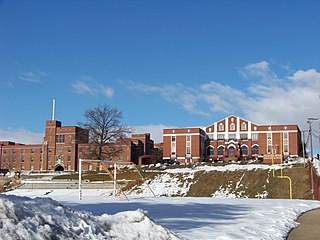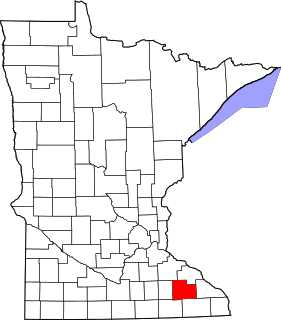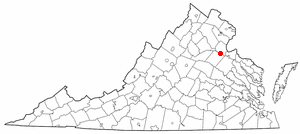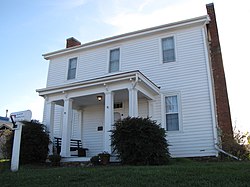
United States Lightship 101, known as Portsmouth, was first stationed at Cape Charles, Virginia. Today she is at the Portsmouth Naval Shipyard Museum in Portsmouth, Virginia. Portsmouth never had a lightship station; however, when the vessel was dry docked there as a museum, she took on the pseudonym Portsmouth. A National Historic Landmark, she is one of a small number of surviving lightships.

Kenmore, also known as Kenmore Plantation, is a plantation house at 1201 Washington Avenue in Fredericksburg, Virginia. Built in the 1770s, it was the home of Fielding and Betty Washington Lewis and is the only surviving structure from the 1,300-acre (530 ha) Kenmore plantation. Betty was the sister of George Washington, the first president of the United States.

Fishburne Military School (FMS) is a private, military boarding school for boys in Waynesboro, Virginia, United States. It was founded by James A. Fishburne in 1879 and is one of the oldest military schools in the country.

The Southwest Virginia Museum Historical State Park is a Virginia museum, run as a state park, dedicated to preserving the history of the southwestern part of the state. It is located in Big Stone Gap, in a house built in the 1880s for Virginia Attorney General Rufus A. Ayers. It was designed and built by Charles A. Johnson. Construction began in 1888 and was completed in 1895.

This is a list of the National Register of Historic Places listings in Monterey County, California.

This is a list of the National Register of Historic Places listings in Crow Wing County, Minnesota. It is intended to be a complete list of the properties and districts on the National Register of Historic Places in Crow Wing County, Minnesota, United States. The locations of National Register properties and districts for which the latitude and longitude coordinates are included below, may be seen in an online map.

This is a list of the National Register of Historic Places listings in Olmsted County, Minnesota. It is intended to be a complete list of the properties and districts on the National Register of Historic Places in Olmsted County, Minnesota, United States. The locations of National Register properties and districts for which the latitude and longitude coordinates are included below, may be seen in an online map.

This is a list of the National Register of Historic Places listings in Henrico County, Virginia.

This is a list of the National Register of Historic Places listings in Cook County, Minnesota. It is intended to be a complete list of the properties and districts on the National Register of Historic Places in Cook County, Minnesota, United States. The locations of National Register properties and districts for which the latitude and longitude coordinates are included below, may be seen in an online map.

This is a list of the National Register of Historic Places listings in Fredericksburg, Virginia.

The Miles B. Carpenter House, a two-story frame dwelling built in 1890, is located at the intersection of Hunter Street and U.S. Route 460 in Waverly, Sussex County, Virginia. It was added to the National Register of Historic Places on November 13, 1989. In 1912 the home was purchased by Miles B. Carpenter, owner of a local sawmill, planing mill, and ice delivery business, who became a noted American folk artist. A photo of the house can be viewed at this referenced website.

The Coiner–Quesenbery House, also known as Casper Coiner House, is a historic home located at Waynesboro, Virginia. It was built in 1806, and is a two-story, three bay, Federal style house. The house originally had a hall and parlor plan, later modified in the 1820s–1830s to a more conventional side hall plan.

The Port Republic Road Historic District is a national historic district in Waynesboro, Virginia. In 2002, it included 83 buildings deemed to contribute to the historic character of the area, plus one other contributing structure and one contributing site, a foundation. They include buildings such as houses, garages, sheds, commercial buildings, churches, and meeting halls, and structures such as carports and animal sheds. The historically African-American neighborhood developed after the American Civil War. Notable buildings include the Shiloh Baptist Church (1924), the early-20th century Elks and Abraham lodges, the Rosenwald School, which incorporates a 1938-39 auditorium/gymnasium, and Tarry's Hotel (1940).

The Waynesboro Downtown Historic District is a national historic district in Waynesboro, Virginia. In 2002, it included 43 contributing buildings in the compact central business district of Waynesboro. The district includes churches, houses, mixed-use commercial buildings, banks, specialty stores, offices, a hotel, restaurants, and parking lots. Notable buildings include the First National Bank (1908–09), the LB&B Building (1929), and the General Wayne Hotel (1937-1938).

The Herndon Depot Museum, also known as the Herndon Historical Society Museum, is located in the town of Herndon in Fairfax County, Virginia. Built in 1857 for the Alexandria, Loudoun & Hampshire Railroad, the depot later served the Richmond and Danville Railroad, the Southern Railway and the Washington and Old Dominion Railroad. The structure is located at 717 Lynn Street, at the intersection of the Washington & Old Dominion Railroad Trail and Station Street, north of Elden Street. The building is adjacent to Town Hall Square, which contains the Herndon Town Hall, built in 1939 as a Works Progress Administration project to house all of the Town's administrative offices.

Royer–Nicodemus House and Farm, also known as the Renfrew Museum and Park, is a historic home and farm located at Waynesboro in Franklin County, Pennsylvania. The main house was built about 1812, and is a 2 1/-2-story, four bay stone dwelling, with a two bay addition built about 1815. It was restored in 1974-1975. The property also includes the brick Fahnestock farmstead (1812), a small stone butcher / smoke house, stone and log milkhouse, and large frame barn with distinctive cupolas built in 1896.
Thomas Jasper Collins, commonly known as T. J. Collins, was an American architect. He served in the Union Army during the American Civil War and later became an architect, practicing first in Washington, D.C., before moving to Staunton, Virginia in 1890. His firm became T. J. Collins & Sons which continued to operate in the 1990s under the management of Collins' grandson. He is credited with the design of numerous courthouses in Virginia and over 200 buildings in Staunton from 1891 to 1911. T.J. Collins retired in 1911; the firm was then run by his sons William and Samuel Collins.

Cambria Freight Station, also known as Christiansburg Depot, is a historic freight station located at Christiansburg, Montgomery County, Virginia. It was built in 1868-1869, and is a wood-framed, one-story, U-shaped structure with a shallow hipped roof and deeply overhanging eaves in the Italianate style. A portion of the center section rises to form a tower-like second-story room, covered with an even shallower hipped roof. A long, one-story freight section extending eastward from the rear. The building also served as a passenger station, until a new passenger station was built nearby on 1906. The building houses a local history museum known as the Cambria Depot Museum.

De Witt Cottage, also known as Holland Cottage and Wittenzand, is a historic home located at Virginia Beach, Virginia. It was built in 1895, and is a two-story, "L" shaped oceanfront brick cottage surrounded on three sides by a one-story porch. It has Queen Anne style decorative detailing. It has a full basement and hipped roof with dormers. A second floor was added to the kitchen wing in 1917. The de Witt family continuously occupied the house as a permanent residence from 1909 to 1988.
























